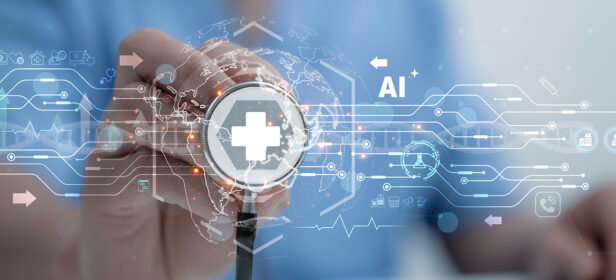The Gist
Medicaid cuts totaling over $940B are triggering the biggest financial shakeup health systems have faced in decades — driving up uncompensated care, shrinking margins, and exposing serious gaps in revenue operations. In this post, AKASA co-founder and healthcare economist Ben Beadle-Ryby breaks down what’s coming, why mid-cycle is your most controllable lever, and how generative AI is already helping leading hospitals recover revenue, reduce denials, and protect quality scores.
The Financial Challenge Before Providers Just Got Worse
The American healthcare system is no stranger to financial headwinds — but the convergence of recent events has created something far more ominous: a perfect storm.
Margins, already razor thin, are now at their most fragile in recent memory. They have been battered by a confluence of events over the past four years. The pandemic upended care volumes and case mix. The 2024 Change Healthcare cyberattack exposed system vulnerabilities. And payers, flush with record profits, have doubled down on aggressive AI-driven claims scrutiny, causing denials to surge. Since 2020, initial denial rates have risen from 10% to nearly 12%, while overturn rates have quietly slipped to just 54%.
Layered atop that: rising labor costs, clinician burnout, and relentless operational complexity.
Amidst this storm, providers now face a new tidal wave: the One Big, Beautiful Bill Act (OBBBA). Signed into law on July 4, 2025, it ushers in over $1 trillion in federal healthcare cuts. The scope of the impact is difficult to overstate:
- More than $940 billion in Medicaid funding is being cut nationwide over the next decade, triggering massive downstream effects — including 16 million projected coverage losses, the rollback of ACA-era gains, new work requirements, and redetermination rules that will drive widespread coverage churn.
- Rural providers alone are projected to lose $155 billion in Medicaid revenue, with only a narrow, politicized $50 billion relief fund offered as a partial offset.
- Provider tax caps will dismantle the core funding model used by 38 states to draw federal Medicaid dollars, compounding the crisis at the state level.
This is not simply a financial challenge. It’s a structural reset for healthcare. For hospitals, the message is clear: adapt or face existential risk.
GenAI as the Financial Lifeline
In the face of this oncoming wave, one technology force has emerged as both unprecedented and essential: generative AI (GenAI).
Why now?
Because for the first time, we have the technology to do something truly transformational.
At its core, generative AI is powered by large language models (LLMs), AI systems trained on vast amounts of data that can understand, interpret, and generate human language with remarkable nuance and context. These models represent a breakthrough in how machines can reason through ambiguity, synthesize massive volumes of information, and produce accurate, contextually aware responses in real time.
Most people have experienced the magic of GenAI through OpenAI’s ChatGPT (or through a similar competitive prompt-based application), but their impact goes well beyond prompting for vacation itinerary ideas or wedding speech support. If ChatGPT was the tip of the spear, enterprise-grade LLMs are the full arsenal.
These models aren’t just answering prompts. They’re rewiring how work gets done across different industries.
- In legal services, LLMs have not only passed the bar exam, but are accelerating contract review, cutting hours of research into minutes.
- In retail banking, customer service chatbots built on LLMs are resolving up to 60% of inbound requests without human escalation.
- In software engineering, GitHub Copilot (an AI that autocompletes code) has already cut development time by over 50% in large-scale orgs.
These aren’t pilots. They’re live. They’re delivering ROI. They’re redefining what productivity looks like. They’re redefining industry as we know it.
And now, it’s healthcare’s turn.
Want more details about this technology? Read 10 Things Healthcare Leaders Need To Know About LLMs and Generative AI.
The Healthcare Use Case: It’s Not the OR — It’s Operations
Healthcare leaders tend to fixate on GenAI’s clinical potential, of which there is certainly significant potential. But the first wedge won’t be surgery. It will be operations.
At Mayo Clinic, LLMs are already being deployed to accelerate intake and summarize clinical histories ahead of visits. Physicians report more relevant notes, less prep time, and fewer duplicative questions.
But perhaps the clearest signal is in revenue cycle, the unsexy but vital machinery that determines whether a hospital gets paid accurately and timely.
Harnessing GenAI in Revenue Cycle Delivers Financial Impact
Nowhere is margin improvement potential more tangible, or more urgent, than in revenue cycle, where health systems spend 2.5% to 4.5% of net patient revenue (NPR) just to capture most of the revenue (I say most because net revenue yield is at 93% for the median performing systems).
In revenue cycle, where does GenAI hit the hardest? In the heart of mid-cycle operations with clinical documentation improvement (CDI) and coding. Here, the human task is staggering:
- The average inpatient record includes 59 clinical documents and contains nearly 50,000 words — the equivalent of reading The Great Gatsby.
- 100% of encounters have to be coded for quality and billing claim purposes, requiring coders to not just sift through and read those 50,000 words over 59 documents, but to pull out all key details to select and sequence the correct set of ICD-10 codes, of which there are over 150,000.
- To get claims out the door in a timely manner, we ask coders to complete this difficult task 6–10 times per day.
So when we audit subsets of these coded claims and find errors, it’s not just understandable human error. It begs the question: why can’t technology help coders more?
With GenAI, we can.
For health systems, the collective administrative burden is enormous. Many large systems employ or contract hundreds of qualified coders, tens of millions of annual labor spend. Because the consequences of under-resourcing this are just too big…
But due to the complexity of a single inpatient claim outlined above, the revenue lost and quality inaccuracies from coding errors or omissions become impossible to ignore.
GenAI changes the equation.
- It can parse massive volumes of clinical text in seconds.
- It can identify missing diagnoses, suggest appropriate CDI queries, and optimize DRG selection before a claim is ever submitted.
- It can enhance PSI, POC, and other quality indicator capture, boosting performance in value-based care contracts.
- It can act as a real-time co-pilot, boosting coder productivity, reducing burnout, and flagging errors that otherwise slip through.
In short, it can help achieve more accurate quality and ensure fair and accurate revenue for care delivered.
Proof in Practice
A $1B NPR regional health system: This organization has not only seen quality improvement, but has fairly boosted in revenue by more than 20 basis points after deploying AKASA Coding Optimizer.
An academic medical center: Leveraged Coding Optimizer to improve coding accuracy, resulting in material quality gains:
- 34% increase in present on admission (POA) capture
- 24% increase in Elixhauser comorbidities
- 20% increase in HCC capture
- 9% and 14% increase in severity of illness and risk of mortality, respectively
This is not theoretical. It’s real results delivering real ROI. And it’s happening now.
A Path Forward
If 2025 is the year of preparation, 2026 will be the year the tidal wave hits the bottom line of health systems. Fortunately, they don’t need to rip-and-replace or overhaul their infrastructure to prepare and get immediate revenue performance improvements from GenAI.
A practical, achievable roadmap exists — and it starts with AKASA’s three-phase approach:
Phase 1: Review Mode
Start with full visibility:
- Receive a customer LLM specific to your health system, generating AI performance curated to your patients, physicians, and payers.
- Deploy AKASA’s Optimizer to review 100% of inpatient encounters pre-bill.
- Surface coding gaps, DRG shifts, documentation improvement opportunities. All AI findings are evidence-based, backed by direct findings from each clinical record.
- Empower human CDI specialists and coders to be more accurate by bringing powerful GenAI insights to their fingertips.
Phase 2: Co-Pilot Mode
Put GenAI in the hands of your team:
- Integrate GenAI suggestions into CDI and coding workflows, effectively enabling GenAI to take the first pass, empowering staff to save time and be more accurate.
- Track improvements in accuracy, compliance, quality, revenue, and staff productivity.
Phase 3: Autonomous Mode
Let GenAI take the lead:
- Allow AI to take autonomous direct-to-bill action on high-confidence recommendations.
- Reduce backlog, improve turnaround time, and minimize cost to collect.
- Expand across service lines, platforms, and facilities.
How To Move Fast With AKASA
Get speed to value:
- No rip-and-replace: Our solutions are fully interoperable and rely on standards-based integrations
- Lightweight implementation and IT lift: We leverage APIs, HL7s, EDIs, so straightforward and with a low lift for IT team support
- Risk-free pilot combined with results-based pricing aligned to realized ROI
Interested in implementing this technology? Get the best practices in this step-by-step resource: Generative AI: A How-To Guide for HIM Leaders.
The Bottom Line: It’s Not Optional
What lies ahead isn’t merely challenging, it’s historic. The fiscal reshaping of the healthcare safety net is already in motion. Hospitals that move now will be positioned to absorb the shock. Those who delay will find themselves under water.
Generative AI isn’t just innovation — it’s future infrastructure.
It’s how we protect margins, reduce burnout, and improve care in the face of daunting pressure. It has the transformational potential that the industry has been seeking for more than 15 years.
Let’s build the future of healthcare with intelligence and resilience. Let’s start today.
Want to find out more? Set up a time to chat with one of our AI experts.

Ben Beadle-Ryby is a senior vice president and co-founder of AKASA. Beadle-Ryby has nearly 15 years of experience as a healthcare economist, specializing in technology and consulting solutions to address financial challenges for hospitals and health systems. Prior to AKASA, Beadle-Ryby was a partner at the Advisory Board Company and at Optum, leading revenue cycle consulting growth and delivery. During his career, he has worked with more than 200 provider organizations across the country, delivering long-term operational improvements. Beadle-Ryby has a degree in mathematical economics from Colorado College.








